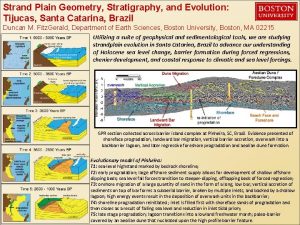Strand Plain Geometry Stratigraphy and Evolution Tijucas Santa

- Slides: 1

Strand Plain Geometry, Stratigraphy, and Evolution: Tijucas, Santa Catarina, Brazil Duncan M. Fitz. Gerald, Department of Earth Sciences, Boston University, Boston, MA 02215 Utilizing a suite of geophysical and sedimentological tools, we are studying strandplain evolution in Santa Catarina, Brazil to advance our understanding of Holocene sea level change, barrier formation during forced regressions, chenier development, and coastal response to climatic and sea level forcings. GPR section collected across barrier island complex at Pinheira, SC, Brazil. Evidence presented of shoreface progradation, landward bar migration, vertical barrier accretion, overwash into a backbarrier lagoon, and later regressive foreshore progradation and aeolian dune formation. Evolutionary model of Pinheira: T 1: sea-level highstand marked by bedrock shoreline; T 2: early progradation; large offshore sediment supply allows for development of shallow offshore dipping beds; sea level fall forces transition to steeper-dipping, offlapping beds of forced regression; T 3: onshore migration of a large quantity of sand in the form of a long, low bar; vertical accretion of sediments on top of bar forms a subaerial barrier, broken by multiple inlets, and backed by a shallow lagoon; high energy events result in the deposition of overwash units in the backbarrier; T 4: shoreline progradation reinitiated. ; inlet is filled first with shoreface sands of progradation and then closes as a result of falling sea level and reduction in inlet tidal prism; T 5: late stage progradation; lagoon transitions into a lowland freshwater marsh; paleo-barrier covered by an aeolian dune that nucleated upon the high profile barrier feature.

